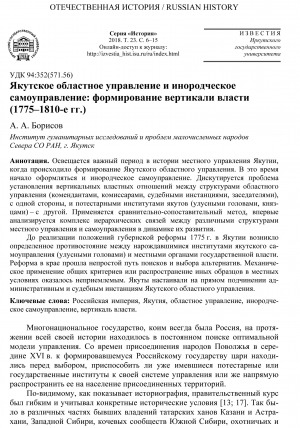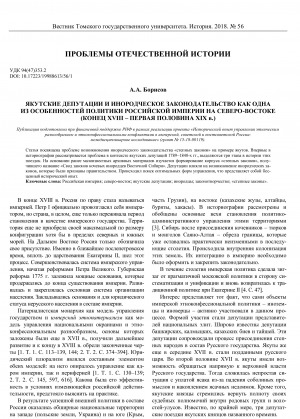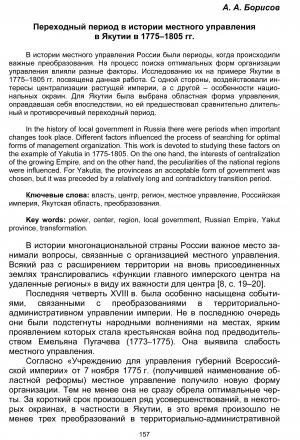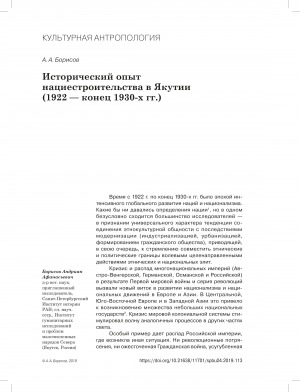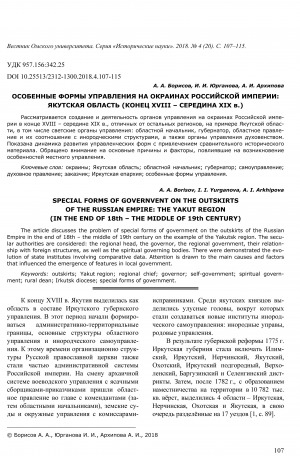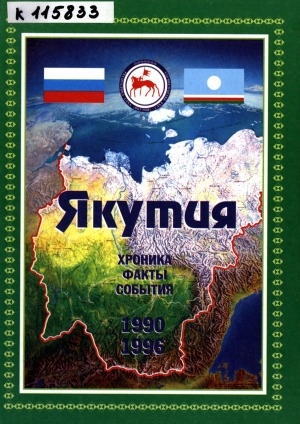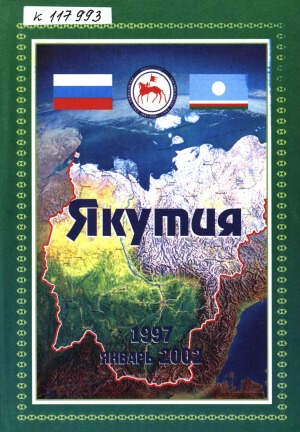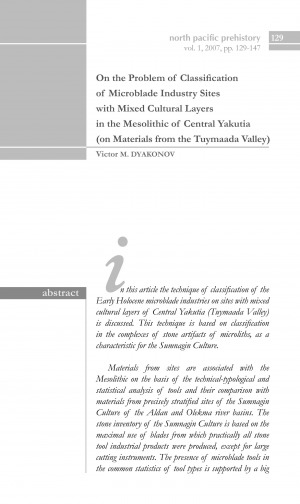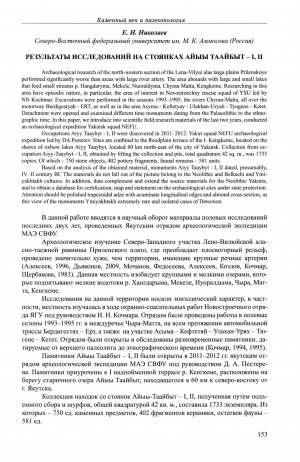Количество страниц: 10 с.
- Якутская Степная дума – первый опыт областного самоуправления > Исторические предпосылки создания Якутской Степной думы,
- Общественные науки. Образование > Государственное административное управление. Военное дело,
- Краеведение. Археология. География. Биографии. История > Историческая наука. Историография > История Якутии > Якутия в XVI-XVIII вв.,
- НАУКА ЯКУТИИ > ОБЩЕСТВЕННЫЕ НАУКИ > Государственное административное управление. Военное дело.
The article focuses on an important period in the history of local administration in Yakutia when indigenous self-government was formed. The author considers formation of the vertical power structure both in regional administration (commandants, commissioners, judicial authorities, assessors) and in potestary institutions and forms of selfgovernment in Yakutia (ulus chiefs, princelings). The author applies comparative method in research. For the first time the hierarchy between various structures of local government and indigenous self-government in Yakutia is analyzed considering dynamics of their formation. Before the provincial reform of 1775 in Yakutia the forming indigenous selfgovernment was opposed to the local government. Undertaking the reform required much effort. It was inappropriate to implement general methods in local conditions. The Yakuts insisted on direct subordination to the administrative and judicial authorities of the Yakut regional administration.
Борисов, А. А. Якутское областное управление и инородческое самоуправление: формирование вертикали власти (1775–1810-е гг.) / А. А. Борисов // Известия Иркутского государственного университета. Серия: История. – 2018. – Т. 23. – С. 6-15.
Количество страниц: 7 с.
- Якутская Степная дума – первый опыт областного самоуправления > Учреждение и деятельность Якутской Степной думы (1827-1838 гг.),
- Республика Саха (Якутия): пути великих свершений > Присоединение к России,
- Общественные науки. Образование > Государственное административное управление. Военное дело,
- Краеведение. Археология. География. Биографии. История > Историческая наука. Историография > История Якутии > Якутия в XVI-XVIII вв.,
- Краеведение. Археология. География. Биографии. История > Историческая наука. Историография > История Якутии > Якутия в XIX в.,
- НАУКА ЯКУТИИ > ОБЩЕСТВЕННЫЕ НАУКИ > Государственное административное управление. Военное дело.
The purpose of the presented article is to consider the role of Yakut deputations in the formation of alien (inorodcheskoe) legislation ("steppe laws"). We contribute the following tasks to achieve this goal: 1) to revise the former estimates of these trips which were interpreted as achieving the narrow corporate (class) interests of the Yakut elite, 2) to characterize the prerequisites and reasons for organizing the deputies, 3) to trace the stages in the development of this movement, 4) to test the thesis about the role of deputies in the formation of alien legislation. The research methodology is based on the concept of multiculturalism policy implemented in the Russian Empire. Legal pluralism became one of the peculiarities of ethnic-confessional policy of the Russian Empire. On the one hand, there was acting official state law, and on the other hand, there was a customary law. The problematic field of research is in the historical and legal space and includes some categories related to the history of Russian legislation on the example of Yakutia. The historical sources of research were the tsarist and Senate decrees, documents of local authorities, artifacts of Yakut customary law. In the course of the research, the author came to the following conclusions. 1) It is very important that deputy trips from the local ethnic elites, in particular, from Yakuts had a major role in the creation of laws for Siberian aliens. The Yakut elite leaders came to the understanding that only a set of measures and, above all, the adoption of legally recognized "steppe laws" could serve as a guarantor o f stable development of the Yakuts. 2) In article the history of yakut deputations was divided on three periods: the first, preparatory (17891811), the second, reformatory (1811 - the middle of 1820s), the third, the struggle for the establishment of "steppe laws" (1829-1840s). 3) The most important outcome of the trips was the formation of "steppe laws" body, known as "Code of nomad ic aliens of Eastern Siberia". On the agenda there was a question of establishment a proper set of laws for aliens, which would regulate all aspects of life of the peoples of Siberia. 4) Although the "Code" was not officially approved, but the practice of the relationship between the imperial government and aliens' leaders demonstrates that the open mutual dialogue had been developing. There was the process of searching the optimum forms of governance that provides an invaluable historical experience.
Борисов, А. А. Якутские депутации и инородческое законодательство как одна из особенностей политики Российской империи на северо-востоке (конец XVIII - первая половина XIX в.) / А. А. Борисов // Вестник Томского государственного университета. История. – 2018. – N 56. – С. 5-11.
DOI: 10.17223/19988613/56/1
Количество страниц: 5 с.
- Якутская Степная дума – первый опыт областного самоуправления > Исторические предпосылки создания Якутской Степной думы,
- Общественные науки. Образование > Государственное административное управление. Военное дело > Низшая ступень органов управления. Местное управление. Общинное управление,
- Краеведение. Археология. География. Биографии. История > Историческая наука. Историография > История Якутии > Якутия в XVI-XVIII вв.,
- Краеведение. Археология. География. Биографии. История > Историческая наука. Историография > История Якутии > Якутия в XIX в.,
- НАУКА ЯКУТИИ > ОБЩЕСТВЕННЫЕ НАУКИ > Государственное административное управление. Военное дело.
In the history of local government in Russia there were periods when important changes took place. Different factors influenced the process of searching for optimal forms of management organization. This work is devoted to studying these factors on the example of Yakutia in 1775-1805. On the one hand, the interests of centralization of the growing Empire, and on the other hand, the peculiarities of the national regions were influenced. For Yakutia, the provinceas an acceptable form of government was chosen, but it was preceded by a relatively long and contradictory transition period.
Борисов, А. А. Переходный период в истории местного управления в Якутии в 1775–1805 гг. / А. А. Борисов // Столица и провинции: взаимоотношение центра и регионов в истории России. – Санкт-Петербург, 2018. – Вып. 9. – С. 157-161.
Количество страниц: 19 с.
This article provides one of the first studies of nation-building in Yakutia from 1922 to the end of the 1930s. The largest ethnic community in this region became the subject of a global process of activating national movements at the site of disintegrated multinational empires of Europe and Asia under the influence of the First World War and subsequent revolutions. This political and cultural project involved both the central authorities of the RSFSR and the USSR, as well as the leadership of the Yakut ASSR, established in 1922. The existing preconditions for the formation of a Yakut nation (commonality of historical destiny, unity of language, existence of a national intelligentsia, etc.) and the political struggle between supporters of centralization and federalism forced the creation of necessary national attributes (autonomy, written national literature, national modernized culture and economy). There were some clear successes achieved by national policies, taking into account local peculiarities (e.g. temporary reconciliation and cooperation with non-partisan intelligentsia, tolerance for believers, most of whom were Yakuts, and creation of mass written language). At the same time, they were hindered by haste in modernizing and raising the cultural level of the Yakut population (spasmodic economic transformation, political ambitions by part of the Yakut intelligentsia not supported by objective conditions, thus encouraging indigenization) Yakutia’s nation-building had two phases: phase 1 (1922 to the end of the 1920s), and phase 2 (late 1920s to the end of the 1930s), which corresponded to stages of prevalence of the national trend and the transition to non-national politics . Among the main results and lessons of nation-building were: truncated autonomy, but the experience of national government (successful experience of internal regionalization and defining the boundaries of the YASSR), defeat of the old national intelligentsia, creation of mass national writing, repression of religion and traditional beliefs, and raising the general cultural level).
Борисов, А. А. Исторический опыт нациестроительства в Якутии (1922 — конец 1930-х гг.) / А. А. Борисов // Новейшая история России. – 2019. – Т. 9, N 1. – С. 214-232. – DOI: 10.21638/11701/spbu24.2019.113.
DOI: 10.21638/11701/spbu24.2019.113
Количество страниц: 9 с.
The article discusses the problem of special forms of government on the outskirts of the Russian Empire in the end of 18th - the middle of 19th century on the example of the Yakutsk region. The secular authorities are considered: the regional head, the governor, the regional government, their relationship with foreign structures, as well as the spiritual governing bodies. There were demonstrated the evolution of state institutes involving comparative data. Attention is drawn to the main causes and factors that influenced the emergence of features in local government.
Издательство: Якутский край
Год выпуска: 2007
Серия, номер выпуска: Кн. 4, ч. 1
Количество страниц: 464 с.
- К 100-летию ЯАССР: Совет народных комиссаров – Правительство > Правительство Республики Саха (Якутия). 1992-2008 гг.,
- Краеведение. Археология. География. Биографии. История,
- ШКОЛА > Школьнику > История > История Якутии,
- ШКОЛА > Педагогу > Преподавание дисциплин > История > История Якутии > Якутия во второй половине 20 века.
Издательство: Якутский край
Год выпуска: 2007
Серия, номер выпуска: Кн. 4, ч. 2
Количество страниц: 608 с.
- К 100-летию ЯАССР: Совет народных комиссаров – Правительство > Правительство Республики Саха (Якутия). Современный период.,
- К 100-летию ЯАССР: видные государственные деятели Якутии XX-XXI вв. > Федоров Валентин Петрович,
- Краеведение. Археология. География. Биографии. История,
- ШКОЛА > Школьнику > История > История Якутии,
- ШКОЛА > Педагогу > Преподавание дисциплин > История > История Якутии > Якутия во второй половине 20 века.
Количество страниц: 19 с.
Работа посвящена проблеме изучения мезолита в Центральной Якутии. Здесь было известно небольшое количество стоянок сумнагинской культуры, характеризующихся смешанными культурными комплексами, и датированных этим временем лишь по аналогиям инвентаря. В работе предложена методика определения раннеголоценовых комплексов в смешанных культурных слоях, основанная на выделении в общих комплексах каменного инвентаря микролитов, в большей степени характерных для сумнагинской культуры. Проведённый анализ позволил выделить сумнагинский культурный комплекс на 11 памятниках Туймаады. На ещё около 25 памятниках, где обнаружены микропластинчатые индустрии, при расширении работ, может подтвердиться предположение о наличии в культурных слоях мезолитического каменного инвентаря
Dyakonov, V. M. On the Problem of Classification of Microblade Industry Sites with Mixed Cultural Layers in the Mesolithic of Central Yakutia (on Materials from the Tuymaada Valley) / Victor M. Dyakonov // North Pacific Prehistory : archaeological studies journal. — 2007. — Vol. 1. — P. 129-147.
Количество страниц: 5 с.
Monuments Aiyy Taaybyt-I,II dated, presumably, IV-II century BC. The materials do not fall out of the picture belong to the Neolithic and Belkachi and Ymiyakhtakh cultures. In addition, data comlement and extend the source materials for the Neolithic Yakutia, and to obtain a database for certification, map and statement on the archaelogical sites under state protection. Attention should be polished trapezoidal adze with acuminate longitudinaledges and almond cross-section, as this view of the monuments Ymiyakhtakh extremely rare and isolated cases of Detection.
Николаев, Е. Н. Результаты исследований на стоянках Айыы Таайбыт-I, II / Е. Н. Николаев // Древние культуры Монголии и Байкальской Сибири : материалы IV Международной научной конференции, Чита, 13-19 сентября 2013 г. : в 2 ч. — 2013. — Ч. 1. — С. 153-157.
Количество страниц: 7 с.
Tuymaada - a large valley of the Lena River, located in Central Yakutia. Archaeological investigations here are conducted more than 100 years. For all the time it is opened about 250 different archaeological sites. 40 of them belong to the Bronze Age, represented here by the Ust'-Mil' Culture (middle II – I millennium BC). Workshops of bronze-casting, sites and 2 burials committed by a ritual of cremation are fpund here. The main material on sites of a Bronze Age of Tuymaada Valley is a smoothly-walls pottery with belts-bolsters and thin walls. The most of tools is made of a stone and a bone. Bronze is found out only in the form of small ingots. Judging by inventory, economy of Ust'-Mil' tribes was based on hunting with a considerable role of fishing and gathering.
Дьяконов, В. М. Бронзовый век долины Туймаада (Центральная Якутия) : история изучения и некоторые итоги работ / В. М. Дьяконов // Древние культуры Монголии и Байкальской Сибири : материалы IV Международной научной конференции, Чита, 13-19 сентября 2013 г. : в 2 ч. — 2013. — Ч. 1. — С. 268-274.
